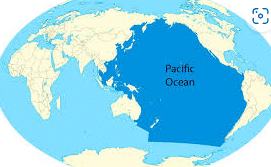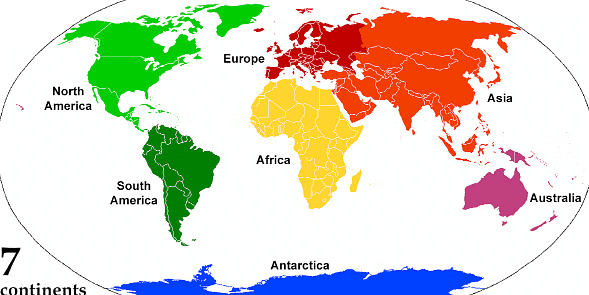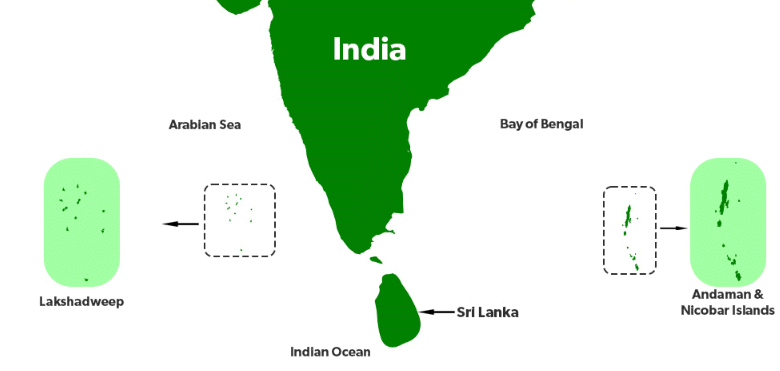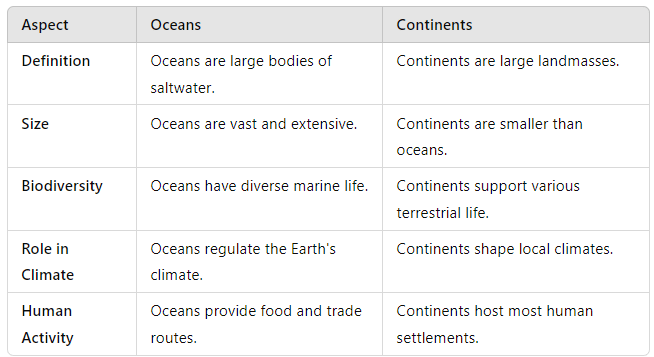Unit Test (Solutions): Oceans and Continents | Social Studies for Class 6 PDF Download
Time: 1 hour
M.M. 30
Attempt all questions.
- Question numbers 1 to 5 carry 1 mark each.
- Question numbers 6 to 8 carry 2 marks each.
- Question numbers 9 to 11 carry 3 marks each.
- Question numbers 12 & 13 carry 5 marks each.
Q1: Which of the following is the largest ocean?
(i) Indian Ocean
(ii) Atlantic Ocean
(iii) Pacific Ocean
(iv) Arctic Ocean
Ans: (iii) Pacific Ocean
The Pacific Ocean is the largest ocean in the world.
Q2: The Earth's surface is covered by approximately ___________ of water.
Ans: three-fourths
Almost three-fourths of the Earth's surface is covered by water.
Q3: The landmass that covers a large continuous expanse is called a ___________.
Ans: continent
A continent is a large continuous expanse of land.
Q4: Which ocean is located to the south of India?
(i) Atlantic Ocean
(ii) Indian Ocean
(iii) Pacific Ocean
(iv) Arctic Ocean
Ans: (ii) Indian Ocean
The Indian Ocean is situated to the south of India.
Q5: The ___________ is the largest island in the world.
Ans: Greenland
Greenland is recognized as the largest island in the world.
Q6: Explain what oceans are.
Ans: i) Oceans are large bodies of saltwater that cover most of the Earth's surface.
ii) They hold most of the planet's water and are vital for supporting marine life.
iii) Oceans play a critical role in regulating the Earth's climate.
Q7: What are continents?
Ans: i) Continents are large land masses on Earth that are surrounded by water.
ii) There are seven continents: Africa, Antarctica, Asia, Australia, Europe, North America, and South America.
iii) Continents have various climates, landscapes, and cultures.
Q8: Why are oceans important for life on Earth?
Ans: i) Oceans produce more than half of the world's oxygen through marine plants.
ii) They are essential for the water cycle, influencing weather patterns and rainfall.
iii) Oceans provide food and livelihoods for millions of people around the world.
Q9: List the five oceans and their features.
Ans: i) Pacific Ocean: The largest ocean, known for its vast size and diversity of marine life.
ii) Atlantic Ocean: The second-largest ocean, known for its important shipping routes and cultural connections.
iii) Indian Ocean: Located to the south of Asia, significant for trade and fisheries.
iv) Arctic Ocean: The smallest and shallowest ocean, covered by sea ice most of the year.
v) Southern Ocean: Surrounds Antarctica and is known for its unique ecosystems and wildlife.
Q10: Describe the impact of oceans on climate.
Ans: i) Oceans regulate the Earth's temperature by absorbing heat from the sun.
ii) They influence weather patterns and are crucial for precipitation through evaporation.
iii) The ocean currents circulate warm and cold water, affecting regional climates and ecosystems.
iv) Without oceans, many areas would become deserts due to lack of rainfall.
Q11: What are islands, and how are they different from continents?
Ans: i) Islands are smaller land masses surrounded by water on all sides.
ii) They can be of various sizes but are not as large as continents.
iii) While continents have a significant land area, islands are relatively small and may not support diverse ecosystems like continents do.
iv) Examples include Greenland (the largest island) and the Andaman and Nicobar Islands (part of India).
Q12: Explain the importance of the ocean for human life.
Ans: i) Source of Food: Oceans provide fish and other seafood, which are vital for human diets worldwide.
ii) Climate Regulation: Oceans help regulate climate by storing heat and influencing weather patterns.
iii) Economic Activities: Many economies rely on oceans for trade, tourism, and fishing industries.
iv) Cultural Significance: Oceans are central to the culture and identity of many coastal communities, influencing their lifestyles and traditions.
v) Biodiversity: Oceans support a vast array of marine life, which is essential for ecological balance.
Q13: Differentiate between oceans and continents.
Ans: 
|
48 videos|307 docs|28 tests
|
FAQs on Unit Test (Solutions): Oceans and Continents - Social Studies for Class 6
| 1. What are the major oceans of the world and their significance? |  |
| 2. How do continents differ from oceans in terms of geography? |  |
| 3. What is the importance of studying oceans and continents in Class 9? |  |
| 4. How do ocean currents affect the climate of nearby continents? |  |
| 5. What are the challenges faced by oceans and continents today? |  |

















